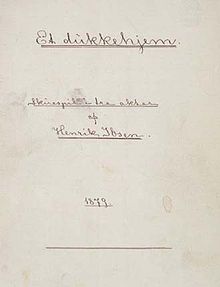A Doll's House
| A Doll's House | |
|---|---|

Original manuscript cover page, 1879
|
|
| Written by | Henrik Ibsen |
| Characters | Nora Torvald Helmer Krogstad Mrs. Linde Dr. Rank Children Anne-Marie Helene |
| Date premiered | 21 December 1879 |
| Place premiered |
Royal Theatre in Copenhagen, Denmark |
| Original language | Danish |
| Subject | The awakening of a middle-class wife and mother. |
| Genre |
Naturalistic / realistic problem play Modern tragedy |
| Setting | The home of the Helmer family in an unspecified Norwegian town or city, circa 1879. |
A Doll's House (Bokmål: Et dukkehjem; also translated as A Doll House) is a three-act play in prose by Henrik Ibsen. It premiered at the Royal Theatre in Copenhagen, Denmark, on 21 December 1879, having been published earlier that month.
The play is significant for its critical attitude toward 19th-century marriage norms. It aroused great controversy at the time, as it concludes with the protagonist, Nora, leaving her husband and children because she wants to discover herself. Ibsen was inspired by the belief that "a woman cannot be herself in modern society," since it is "an exclusively male society, with laws made by men and with prosecutors and judges who assess feminine conduct from a masculine standpoint." Its ideas can also be seen as having a wider application: Michael Meyer argued that the play's theme is not women's rights, but rather "the need of every individual to find out the kind of person he or she really is and to strive to become that person." In a speech given to the Norwegian Association for Women's Rights in 1898, Ibsen insisted that he "must disclaim the honor of having consciously worked for the women's rights movement," since he wrote "without any conscious thought of making propaganda," his task having been "the description of humanity."
In 2006, the centennial of Ibsen's death, A Doll's House held the distinction of being the world's most performed play for that year.UNESCO has inscribed Ibsen's autographed manuscripts of A Doll's House on the Memory of the World Register in 2001, in recognition of their historical value.
The title of the play is most commonly translated as A Doll's House, though some scholars use A Doll House. John Simon argues that the only significance in the alternative translation is the difference in the way the toy is named in Britain and the United States. Egil Törnqvist argues that the alternative "simply sounds more idiomatic to Americans."
...
Wikipedia
